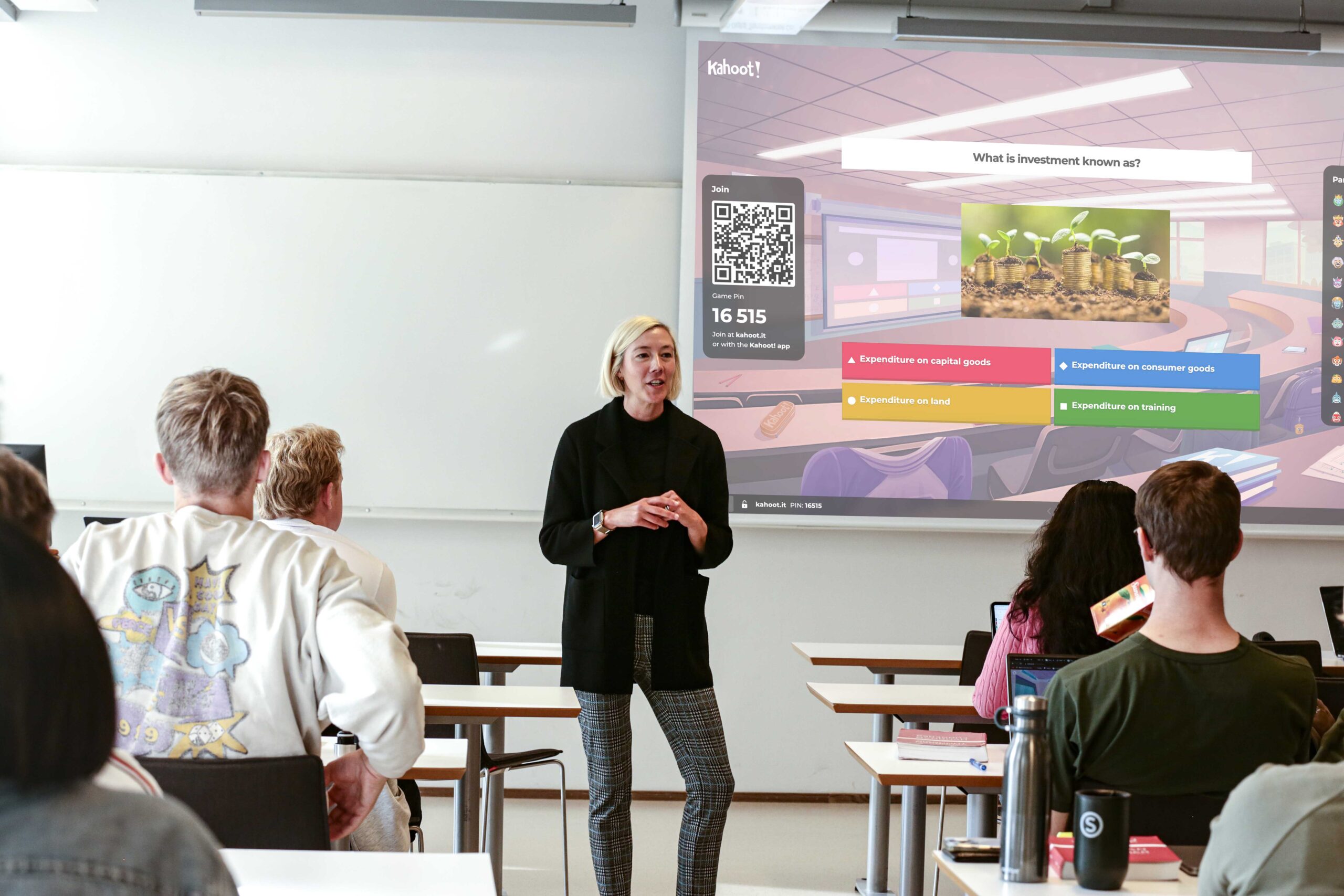
Higher education classrooms face a unique challenge: how do you keep a large and often diverse audience engaged in a traditional lecture setting? With Kahoot!’s lecture mode, instructors have a dynamic toolkit designed for introducing new material, pacing lectures effectively, and minimizing distractions—all while keeping students actively involved. Read on to discover three innovative ways our ambassadors recommend using Kahoot! lecture mode in your lecture hall. You’ll also explore how this new Kahoot! dynamic supports meaningful learning experiences for students.
Seamlessly introducing new concepts
Introducing new concepts can be a challenge, especially in subjects that build foundational knowledge quickly. Kahoot! lecture mode allows educators to pace content delivery, so students have ample time to understand the basics before moving on to more complex ideas.
“[Lecture mode] allows educators to gather data without showing pupils if they were correct or not, extremely useful for doing research in education as the same quiz could be used twice – before and after the lesson for a pre- and post-test format,” suggests Derek F., a university educator in King Cetshwayo, South Africa.
Example in practice: Suppose you’re teaching an introductory course in environmental science and introducing students to the greenhouse effect. Start with a Kahoot! multiple-choice quiz question type that checks for any baseline knowledge, like asking students to identify greenhouse gasses. Then, use lecture mode’s pacing control to deliver slides at your speed, allowing you to pause for explanations or address questions as they arise. This controlled pacing ensures students have time to grasp the fundamentals without feeling overwhelmed.
Why it works: Lecture mode’s pacing feature gives you control over the tempo of the lecture, making it easier to introduce complex material in manageable chunks. This tailored pace is essential when you’re establishing foundational knowledge that students will build on throughout the semester.
Engaging class discussions without distractions
Engaging students in discussion is invaluable for critical thinking, yet large lectures can make it hard to balance engagement with the need to stay on track. With lecture mode, Kahoot! hides the scoreboard and podium by default, keeping the focus on the material rather than competition.
Example in practice: In a sociology class discussing social issues, start by presenting real-world scenarios. Use open-ended questions or poll slides to gather students’ perspectives on each scenario without turning it into a competition. By focusing solely on the discussion, students feel encouraged to participate and explore complex ideas without the pressure of being ranked.
Why it works: Hiding the scoreboard and podium helps maintain a serious, reflective tone when tackling complex or sensitive topics. This allows students to feel more comfortable contributing ideas and encourages thoughtful participation over competitive answering.
Creating a smoother and seamless learning experience
Kahoot!’s lecture mode reduces animations, making it ideal for educators who want a streamlined experience that focuses on content rather than visuals. For large, content-heavy lectures, this helps minimize distractions and keeps students centered on the lesson. Keke, an educator in Austin, Texas explains: “Lecture mode is great to stop and have a pause point through the content being taught. It allows my students to process what is being learned.”
Example in practice: Imagine you’re lecturing in a history class about a significant event, like the fall of the Berlin Wall. After presenting key information, you might pause and launch a discussion prompt or short quiz question to ensure understanding. With reduced animations, lecture mode allows for smooth transitions from one question or discussion point to the next, so students stay on track without getting sidetracked by flashy visuals.
Why it works: Reduced animations keep the lecture flow steady and focused. This creates a more academic environment that’s especially suited to higher education, where content depth and attention are prioritized over energetic visuals.
Supporting inclusive learning with privacy and anonymity
One of the most thoughtful aspects of lecture mode is its default removal of scoring and leaderboards, making it an excellent choice for diverse learning environments. For mixed-ability or special education classrooms, and for any instructor focused on student privacy, this feature helps create a non-competitive, inclusive atmosphere that respects individual progress.
Example in practice: In a classroom with mixed abilities, such as an introductory language class or a neurodivergent inclusion classroom, Kahoot! can assess comprehension on new terms or review previous material without assigning scores. This allows students to focus on their understanding rather than on performance metrics. For classrooms aiming to add anonymity, lecture mode’s privacy-friendly design ensures students’ responses are viewed collectively, keeping individual progress private.
Why it works: Without scoreboards or leaderboards, students of varying skill levels feel less pressure to compete and can participate at their own pace. It’s a supportive setup for students who may feel self-conscious about their progress, particularly those in special education settings or classrooms focused on differentiated learning.
Start transforming your lectures with Kahoot! lecture mode
Lecture mode is designed for educators who want to enrich their lectures with interactive elements that still respect the rhythm of a traditional classroom. Whether you’re looking to control the pace, introduce new material, or foster thoughtful discussions, lecture mode gives you the flexibility to do so seamlessly. Ready to elevate your lecture experience? Lecture mode – and so many other awesome presentation tools – are available with Kahoot!+ Silver, Gold, and EDU plans. Log in to Kahoot!, explore game mode settings in a live game, and start designing a lecture that blends the best of digital engagement with focused learning.




